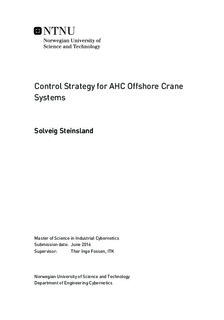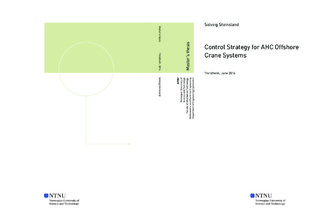| dc.description.abstract | This master's thesis presents a mathematical model of MacGregor`s AHC offshore crane and examines control strategies for the crane system. This crane is placed on ships and is designed for safe and accurate offshore and deepwater subsea lifting operations. The objective of the crane is to compensate for the wave impact. Today MacGregor compensate for wave influence in heave direction using the wire only. This decision could be questioned considering the the impact the waves have on the xy-plane, especially when the crane carries out difficult tasks that require high precision. Hence the objective of this thesis is to investigate the possibility of compensating for the movements in the xy-plane with the intention of increasing the value and usability of the crane.
In order to achieve the objective it was necessary to model the crane mathematically and implement it in MATLAB. The next objective was to suggest a variety of control strategies and identify which was most beneficial to the purposes of the crane. In the interest of keeping MacGregor's existing wire compensating system in the future, the heave movements are compensated by the wire only. The control system is compensating for the wave influence on xy-plane and due to the slowness of the crane, the design becomes crucial. Since the desired tasks are specified in the operational space and require precise control of the crane tip motion, it was decided to use operational space control methods. Four different operational space controller methods were chosen and compared. The first two controllers, Jacobian inverse control and Jacobian transpose control, are intuitive and nonmodel based. The last two controllers, PD control with gravity compensation and Inverse dynamics control, were model based which meant that the mathematical models were included in the control system. The results implies that the two first controllers, that were nonmodel-based, were not able to compensate for the wave movement in the surge and sway direction , and therefore not recommended for MacGregor. On the other hand, the two last model-based controllers behaved unexpectedly satisfying. Further investigation remains before any certain conclusions can be made, but this thesis provides a solid foundation.
Because there has been no prior investigation of this, a critical approach to the result is appropriate. There are several aspects concerning the outcome that can be associated with uncertainty including some simplifications of the system, potential errors in the crane specifications and not least the fact that it is a theoretical approach. Regardless I am confident they will provide MacGregor with ideas and inspiration on how to improve their system. | |

